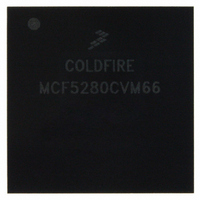MCF5280CVM66 Freescale Semiconductor, MCF5280CVM66 Datasheet - Page 142

MCF5280CVM66
Manufacturer Part Number
MCF5280CVM66
Description
IC MPU 32BIT COLDF 256-MAPBGA
Manufacturer
Freescale Semiconductor
Series
MCF528xr
Datasheet
1.MCF5216CVM66J.pdf
(766 pages)
Specifications of MCF5280CVM66
Core Processor
Coldfire V2
Core Size
32-Bit
Speed
66MHz
Connectivity
CAN, EBI/EMI, Ethernet, I²C, SPI, UART/USART
Peripherals
DMA, LVD, POR, PWM, WDT
Number Of I /o
142
Program Memory Type
ROMless
Ram Size
64K x 8
Voltage - Supply (vcc/vdd)
2.7 V ~ 3.6 V
Data Converters
A/D 8x10b
Oscillator Type
External
Operating Temperature
-40°C ~ 85°C
Package / Case
256-MAPBGA
Controller Family/series
ColdFire
No. Of I/o's
150
Program Memory Size
2KB
Ram Memory Size
64KB
Cpu Speed
66.67MHz
Embedded Interface Type
CAN, I2C, SPI, UART
No. Of Pwm Channels
8
Rohs Compliant
Yes
Lead Free Status / RoHS Status
Lead free / RoHS Compliant
Eeprom Size
-
Program Memory Size
-
Available stocks
Company
Part Number
Manufacturer
Quantity
Price
Company:
Part Number:
MCF5280CVM66
Manufacturer:
FREESCAL
Quantity:
151
Company:
Part Number:
MCF5280CVM66
Manufacturer:
Freescale Semiconductor
Quantity:
10 000
Company:
Part Number:
MCF5280CVM66J
Manufacturer:
Freescale Semiconductor
Quantity:
10 000
Company:
Part Number:
MCF5280CVM66L
Manufacturer:
FREESCAL
Quantity:
151
- Current page: 142 of 766
- Download datasheet (9Mb)
Power Management
7.3.1.2
Wait mode is intended to be used to stop only the CPU and memory clocks until a wakeup event is
detected. In this mode, peripherals may be programmed to continue operating and can generate interrupts,
which cause the CPU to exit from wait mode.
7.3.1.3
Doze mode affects the CPU in the same manner as wait mode, except that each peripheral defines
individual operational characteristics in doze mode. Peripherals which continue to run and have the
capability of producing interrupts may cause the CPU to exit the doze mode and return to run mode.
Peripherals which are stopped will restart operation on exit from doze mode as defined for each peripheral.
7.3.1.4
Stop mode affects the CPU in the same manner as the wait and doze modes, except that all clocks to the
system are stopped and the peripherals cease operation.
Stop mode must be entered in a controlled manner to ensure that any current operation is properly
terminated. When exiting stop mode, most peripherals retain their pre-stop status and resume operation.
The following subsections specify the operation of each module while in and when exiting low-power
modes.
7.3.1.5
Most peripherals may be disabled by software in order to cease internal clock generation and remain in a
static state. Each peripheral has its own specific disabling sequence (refer to each peripheral description
for further details). A peripheral may be disabled at any time and will remain disabled during any
low-power mode of operation.
7.3.2
7.3.2.1
The ColdFire core is disabled during any low-power mode. No recovery time is required when exiting any
low-power mode.
7.3.2.2
SRAM is disabled during any low-power mode. No recovery time is required when exiting any low-power
mode.
7-6
Peripheral Behavior in Low-Power Modes
Wait Mode
Doze Mode
Stop Mode
Peripheral Shut Down
ColdFire Core
Static Random-Access Memory (SRAM)
Entering stop mode will disable the SDRAMC including the refresh counter.
If SDRAM is used, then code is required to insure proper entry and exit from
stop mode. See
information.
MCF5282 and MCF5216 ColdFire Microcontroller User’s Manual, Rev. 3
Section 7.3.2.5, “SDRAM Controller
NOTE
(SDRAMC)” for more
Freescale Semiconductor
Related parts for MCF5280CVM66
Image
Part Number
Description
Manufacturer
Datasheet
Request
R
Part Number:
Description:
Manufacturer:
Freescale Semiconductor, Inc
Datasheet:
Part Number:
Description:
Manufacturer:
Freescale Semiconductor, Inc
Datasheet:
Part Number:
Description:
Manufacturer:
Freescale Semiconductor, Inc
Datasheet:
Part Number:
Description:
Manufacturer:
Freescale Semiconductor, Inc
Datasheet:
Part Number:
Description:
Manufacturer:
Freescale Semiconductor, Inc
Datasheet:
Part Number:
Description:
Manufacturer:
Freescale Semiconductor, Inc
Datasheet:
Part Number:
Description:
Manufacturer:
Freescale Semiconductor, Inc
Datasheet:
Part Number:
Description:
Manufacturer:
Freescale Semiconductor, Inc
Datasheet:
Part Number:
Description:
Manufacturer:
Freescale Semiconductor, Inc
Datasheet:
Part Number:
Description:
Manufacturer:
Freescale Semiconductor, Inc
Datasheet:
Part Number:
Description:
Manufacturer:
Freescale Semiconductor, Inc
Datasheet:
Part Number:
Description:
Manufacturer:
Freescale Semiconductor, Inc
Datasheet:
Part Number:
Description:
Manufacturer:
Freescale Semiconductor, Inc
Datasheet:
Part Number:
Description:
Manufacturer:
Freescale Semiconductor, Inc
Datasheet:
Part Number:
Description:
Manufacturer:
Freescale Semiconductor, Inc
Datasheet:











